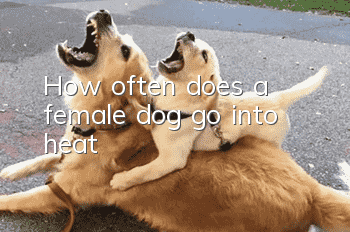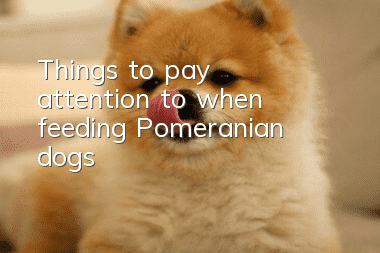[Clicker Training] Clicker training method for dogs
![[Clicker Training] Clicker training method for dogs](/d/file/img/25804.png)
The clicker uses the clicking sound of the clicker as a bridge between behavior and reward to restrict and enhance dog training. It is used to express the dog's rewards and punishments and guide the dog to make correct behaviors and actions. Bad behavior gradually disappears!
Clicker training method steps:
1. There are three methods of clicker training, one is Magnet, one is Capture, and the other is Shaping. The induction method is faster but not accurate, and often leads to confusion or confusion. The capture method is more natural and accurate, but the initial training time is longer. The shaping method is actually to decompose the behavior or action we want to train into many approaching steps, and then use the capturing method to train one by one and connect the approaching steps to achieve the behavior or action we want to train. Induction method (Magnet): Use snacks to induce the dog to produce the behavior or action expected by the trainer. Once the dog does it correctly, press the clicker and reward it with snacks. Capture method: Do not use snacks, gestures or sounds at all, and observe the dog's behavior or movements in detail. Once the dog performs the behavior or movement expected by the trainer, immediately press the clicker and follow it. Give snack rewards. Shaping method: Do not use cues such as snacks or gestures at all. Observe the dog's behavior or movements in detail. Once the dog begins to react to the behavior or movement expected by the dog owner, immediately press the clicker and follow up. Give snack rewards. It can also be said that the behavior or action expected by the trainer is broken down into steps. Each step is trained using the capture method to gradually achieve the behavior or action expected by the dog owner.
2. C&T - This is the abbreviation of Click and Treat, which means when the dog shows the behavior we want, press the clicker and then give the treat immediately.
3. Generalization—This refers to general training, which means repeating more than one clicker training many times in various environments or occasions to prevent the dog from being restricted by the environment. When choosing occasions and environments, the factors and quantity of interference must be gradually increased.
4. Cue—we call it a cue. When the dog has repeatedly gone through C&T to strengthen its behavior many times, you can add a cue before the C&T. The cue can be a verbal prompt (password) or a gesture, and gradually advance the cue to the behavior or action. before the start.
5. Fading Clicker - Gradually eliminate the clicker. When the dog completes the correct behavior, first verbally say "Good" or "Yes", then press the clicker and then give a snack reward. Repeat the above steps and gradually reduce the number of clickers.
Notes on clicker training:
1. As long as you press the clicker, you must give a snack and never break your promise, so that the dog will understand that the clicking sound of the clicker is a promise that he is about to get a snack. The clicker is not a compliment, but a covenant between human and dog, so even if the clicker is clicked by mistake, a treat must be given.
2. Clicker training is a game for dogs. The meaning of this game is: there is something the dog wants from the dog owner, but it must do something for you to get it.
3. Timing is better than everything. The timing of pressing the clicker is very important. Usually the timing of pressing the clicker is too slow, but we can't feel it ourselves. This requires practice. If necessary, ask others to watch.
4. Pressing the clicker represents the end of the action. Therefore, please do not use pressing the clicker to represent "continue the action".
5. Please do not use the clicking sound of the clicker as a signal to attract your dog's attention.
6. If you must use a leash for safety reasons or to limit the range, please use the leash to tie the dog, but do not hold it in your hand to avoid letting the leash mistransmit your message or inadvertently induce it, that is, Say no to treating the leash as a training tool.
7. Don’t use negation to ask your dog to obey during clicker training. Clicker training is not based on commands. If your dog does not respond to your prompts, it usually means that it has not fully learned the prompt, and it is not disobedience. , so you should find more possibilities to prompt it, so that it can complete the response you expect under an easier-to-achieve environment before pressing the clicker.
8. When you are in a bad mood, please do not use clickers. Do not use scolding, punishment, tugging on the leash and other behavioral correction techniques in clicker training. Otherwise, you will not only lose your dog's participation. The clicker trains your confidence, but also makes it lose its confidence in you.
9. Clicker training is a training method that can promote the intimate relationship between you and your dog, so the training process must be enjoyable and enjoyable.
10. Please set the training goal very low at the beginning so that the dog will definitely succeed and succeed again and again. At the same time, plan and arrange its training environment so that it cannot make mistakes. Such training results will exceed your expectations and be more effective. If it is efficient, your dog will prefer clicker training.
- Why is the dog losing hair in patches?
- Is the Corgi's unformed stool caused by catching a cold? What causes it?
- Why are Basenji dogs banned?
- More than 50% of dogs suffer from this disease, but most dogs ignore it! ! !
- How to take care of Samoyed’s hair
- Which pet dog is the smartest? Pet dog IQ rankings!
- What are the main reasons for dog hair loss?
- What are the symptoms when a dog is infected with ticks? How to reduce the risk of tick infection in dogs?
- What buying tips do you need to know when choosing a Scottish Sheepdog?
- 3 Reasons Dog Vaccines Fail



